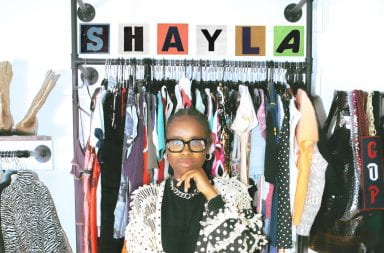
A print of a piece of wearable art by Greg Ponchak. He is set to exhibit alongside Kyle Franklin throughout January at ROY G BIV Gallery. Credit: Courtesy of Greg Ponchak.
Although no intended parallel exists between Kyle Franklin’s and Greg Ponchak’s work, the two artists are set to express personal ideologies and break norms under the same roof throughout January.
After the exhibition’s opening Saturday, ROY G BIV Gallery is set to house Franklin’s and Ponchak’s individual exhibits this month. Both hailing from the Columbus College of Art and Design, the artists are slated to show their interdisciplinary artwork challenging traditional societal ideas side by side.
In using what he describes as a mix of traditional and non-traditional materials, including glitter and towels, as his chosen medium, Franklin said he questions the meaning of the word “traditional” itself in tackling the classical connotations of masculinity in his exhibit.
“People throw around that term,” Franklin said. “Like in this day, what is that? Everything is sort of contemporary enough where traditional isn’t really anything.”
Franklin said his work is about blurring the line dividing the conventional notions of what is means to be a man with his own thoughts on masculinity.
He attributes his inspiration to his own childhood growing up in a small town in Illinois.
“When I was younger, I used to take dance classes, but I also raced motocross at the same time,” Franklin said. “There was this weird moment when, (there was) a line between, ‘Was I considered feminine, was I considered masculine?’ And so this (show) is just saying that I think it’s all kind of the same thing and … femininity is a part of masculinity and vice versa.”
This “line” in Franklin’s exhibit is often displayed in the literal sense, whether through a physical drawing of one or represented through the shape of objects used to construct a sculpture.
One of Franklin’s sculptures features a piece of wood based on marble, leaning against the wall with a towel pinned between the wall and the end of the plank.
“Greek bathhouses were a place where men used to congregate, and it used to be the very typical view of masculinity and the very typical hero,” Franklin said. “So the more that I went about high school culture, like sports culture, (I thought) about the shower room as being the kind of contemporary version of the Greek bathhouse.”
The showing of Ponchak’s exhibit alongside Franklin’s had Ponchak thinking largely about similarities between their shows, he said. He finds their similarities in the nature of the artists’ chosen mediums.
“Most of the pieces that I’ve made for the show, I guess I’ve been working at the sewing machine, I don’t know, gardening, and maybe in some way, the things that are traditionally associated with female gender roles,” Ponchak said.
Same to Franklin’s use of sculpture in his exhibit, Ponchak’s exhibit uses this as well. Additionally, Ponchak uses digital art and photography to build upon his theme of survival within the context of capitalism. He said his inspiration is drawn from reading the works of Italian Marxist author Franco Berardi as well as stories he has recently seen on the news.
“There’s obviously the physiological survival that happens in nature,” Ponchak said. “I mean, there’s this set of primary conditions that need to be met, like food and shelter, but it gets more complex in that our existence is virtual.”
Ponchak’s exhibit includes a variety of common objects accented by his own take, including planter boxes with live vegetation and sculptural pieces that look similar to coffee tables, he said. Ponchak also created “functional objects which were photographed and processed digitally then displayed as print objects,” he said in an email, including a scarf designed to free the eyes but cover the rest of the face.
These items of survival are based largely on Ponchak’s own current state of survival.
“My current situation, the one that I find myself in, is one of sort of economic austerity, and all the objects I’ve made for the show kind of develop out of a necessity,” Ponchak said. “I could buy a pair of pants for $40 or I could make one for $10 and there’s sort of the distance that’s removed in that I’m making the object.”
ROY G BIV Gallery is located at 997 N. High St. The gallery is open Wednesday to Friday, 3-6 p.m. and Saturday, 1-5 p.m.
An earlier version of this story stated Ponchak created wearable items for his exhibit. In fact, Ponchak “created functional objects which were photographed and processed digitally then displayed as print objects,” he said in an email.


![Local fashion experts guide college students through shopping and dressing for their upcoming summer jobs or internships. Credit: Dreamstime (via TNS) [Original caption: How does smart casual differ from snappy casual, glitzy casual, dressy casual, party casual and business casual?]](https://www.thelantern.com/files/2024/04/LIFE-FAM-BORGMAN-COLUMN-DMT-7432064dd4242c4c-384x253.jpg)